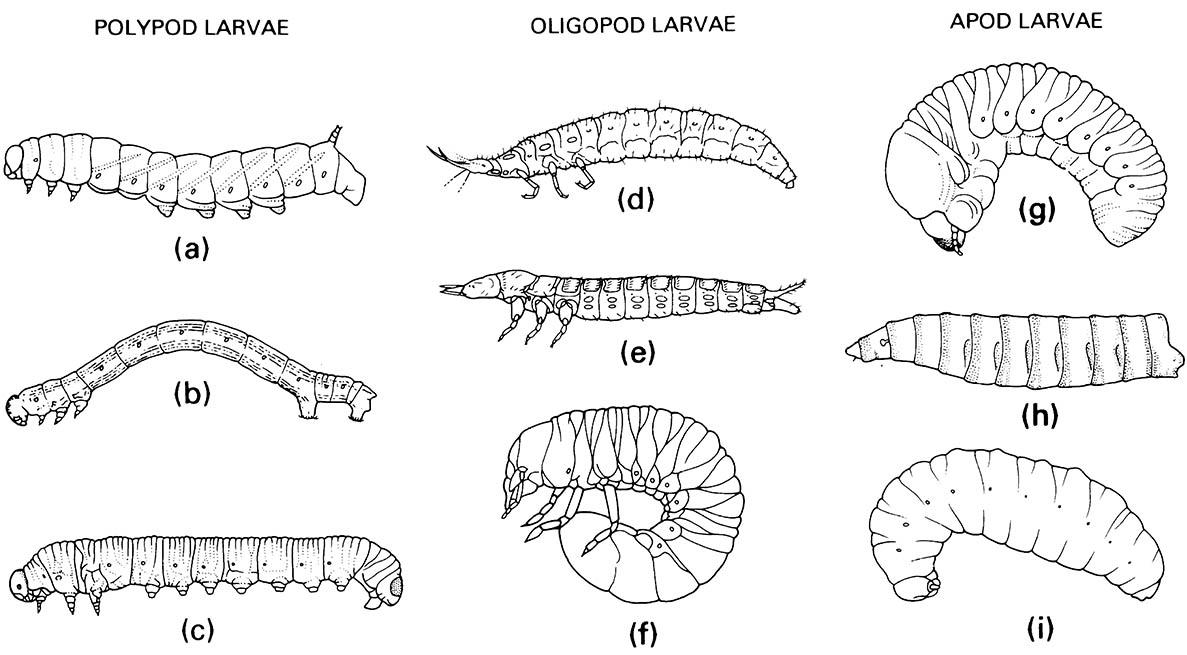6.2.2. Larval or nymphal phase
Hatching from the egg may be by a pronymph, nymph, or larva: eclosion conventionally marks the beginning of the first stadium, when the young insect is said to be in its first instar (Fig. 6.1). This stage ends at the first ecdysis when the old cuticle is cast to reveal the insect in its second instar. Third and often subsequent instars generally follow. Thus, the development of the immature insect is characterized by repeated molts separated by periods of feeding, with hemimetabolous insects generally undergoing more molts to reach adulthood than holometabolous insects.
All immature holometabolous insects are called larvae. Immature terrestrial insects with hemimetabolous development such as cockroaches (Blattodea), grasshoppers (Orthoptera), mantids (Mantodea), and bugs (Hemiptera) always are called nymphs. However, immature individuals of aquatic hemimetabolous insects (Odonata, Ephemeroptera, and Plecoptera), although possessing external wing pads at least in later instars, also are frequently, but incorrectly, referred to as larvae (or sometimes naiads). True larvae look very different from the final adult form in every instar, whereas nymphs more closely approach the adult appearance at each successive molt. Larval diets and lifestyles are very different from those of their adults. In contrast, nymphs often eat the same food and coexist with the adults of their species. Competition thus is rare between larvae and their adults but is likely to be prevalent between nymphs and their adults.
The great variety of endopterygote larvae can be classified into a few functional rather than phylogenetic types. Often the same larval type occurs convergently in unrelated orders. The three commonest forms are the polypod, oligopod, and apod larvae (Fig. 6.6). Lepidopteran caterpillars (Fig. 6.6a,b) are characteristic polypod larvae with cylindrical bodies with short thoracic legs and abdominal prolegs (pseudopods). Symphytan Hymenoptera (sawflies; Fig. 6.6c) and most Mecoptera also have polypod larvae. Such larvae are rather inactive and are mostly phytophagous. Oligopod larvae (Fig. 6.6d-f ) lack abdominal prolegs but have functional thoracic legs and frequently prognathous mouthparts. Many are active predators but others are slow-moving detritivores living in soil or are phytophages. This larval type occurs in at least some members of most orders of insects but not in the Lepidoptera, Mecoptera, Diptera, Siphonaptera, or Strepsiptera. Apod larvae (Fig. 6.6g-i) lack true legs and are usually worm-like or maggot-like, living in soil, mud, dung, decaying plant or animal matter, or within the bodies of other organisms as parasitoids (Chapter 13). The Siphonaptera, aculeate Hymenoptera, nematoceran Diptera, and many Coleoptera typically have apod larvae with a well-developed head, whereas in the maggots of higher Diptera the mouth hooks may be the only obvious evidence of the cephalic region. The grub-like apod larvae of some parasitic and gall- inducing wasps and flies are greatly reduced in external structure and are difficult to identify to order level even by a specialist entomologist. Furthermore, the early-instar larvae of some parasitic wasps resemble a naked embryo but change into typical apod larvae in later instars.
A major change in form during the larval phase, such as different larval types in different instars, is called larval heteromorphosis (or hypermetamorphosis). In the Strepsiptera and certain beetles this involves an active first-instar larva, or triungulin, followed by several grub-like, inactive, sometimes legless, later-instar larvae. This developmental phenomenon occurs most commonly in parasitic insects in which a mobile first instar is necessary for host location and entry. Larval heteromorphosis and diverse larval types are typical of many parasitic wasps, as mentioned above.


(a) Lepidoptera: Sphingidae; (b) Lepidoptera: Geometridae; (c) Hymenoptera: Diprionidae. Oligopod larvae: (d) Neuroptera: Osmylidae; (e) Coleoptera: Carabidae; (f ) Coleoptera: Scarabaeidae. Apod larvae: (g) Coleoptera: Scolytidae; (h) Diptera: Calliphoridae; (i) Hymenoptera: Vespidae. ((a, e-g) After Chu 1949; (b, c) after Borror et al. 1989; (h) after Ferrar 1987; (i) after CSIRO 1970)

